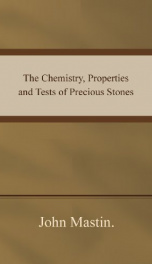The Chemistry, Properties and Tests of Precious Stones

What constitutes a precious stone is the question which, at the onset,rises in the mind, and this question, simple as it seems, is one by nomeans easy to answer, since what may be considered precious at one time,may cease to be so at another.There are, however, certain minerals which possess distinctive featuresin their qualities of hardness, colour, transparency, refractability ordouble refractability to light-beams, which qualities place them in anentirely different class to the minerals of a metallic nature. Theseparticular and non-metallic minerals, therefore, because of theircomparative rarity, rise pre-eminently above other minerals, and becomeactually "precious."This is, at the same time, but a comparative term, for it will readilybe understood that in the case of a sudden flooding of the market withone class of stone, even if it should be one hitherto rare andprecious, there would be an equally sudden drop in the intrinsic valueof the jewel to such an extent as perhaps to wipe it out of the categoryof precious stones. For instance, rubies were discovered long beforediamonds; then when diamonds were found these were considered much morevaluable till their abundance made them common, and they became oflittle account. Rubies again asserted their position as chief of allprecious stones in value, and in many biblical references rubies arequoted as being the symbol of the very acme of wealth, such as inProverbs, chapter iii., verses 13 and 15, where there are the passages,"happy is the man that findeth wisdom ... she is more precious thanrubies"--and this, notwithstanding the enormous quantity of them at thattime obtained from the ruby mines of Ophir and Nubia, which were thenthe chief sources of wealth.It will also be remembered that Josephus relates how, at the fall ofJerusalem, the spoil of gold was so great that Syria was inundated withit, and the value of gold there quickly dropped to one-half; otherhistorians, also, speaking of this time, record such a glut of gold,silver, and jewels in Syria, as made them of little value, which statecontinued for some considerable period, till the untold wealth becameruthlessly and wastefully scattered, when the normal values slowlyreasserted themselves.Amongst so many varieties of these precious minerals, it cannot beotherwise than that there should be important differences in theirvarious characteristics, though for a stone to have the slightest claimto be classed as "precious" it must conform to several at least of thefollowing requirements:--It must withstand the action of light withoutdeterioration of its beauty, lustre, or substance, and it must be ofsufficient hardness to retain its form, purity and lustre under theactions of warmth, reasonable wear, and the dust which falls upon itduring use; it must not be subject to chemical change, decomposition,disintegration, or other alteration of its substance under exposure toatmospheric air; otherwise it is useless for all practical purposes ofadornment or ornamentation.There are certain other characteristics of these curious minerals whichmay be classified briefly, thus:--Some stones owe their beauty to awonderful play of colour or fire, due to the action of light, quiteapart from the colour of the stone itself, and of this series the opalmay be taken as a type. In others, this splendid play of colour isaltogether absent, the colour being associated with the stone itself, inits substance, the charm lying entirely in the superb transparency, theruby being taken as an example of this class of stone. Others, again,have not only colour, but transparency and lustre, as in the coloureddiamonds, whilst the commoner well-known diamonds are extremely rich intransparency and lustre, the play of light alone showing a considerableamount of brilliancy and beauty of colour, though the stone itself isclear. Still others are opaque, or semi-opaque, or practically free fromplay of light
Info about the book
Author:
Series:
Unknown
ASIN:
B0082W7556
Rating:
3/5 (2)Your rating:
0/5
Languge:
English
Users who have this book
Users who want this book
What readers are saying
What do you think? Write your own comment on this book!
write a commentif you like The Chemistry, Properties and Tests of Precious Stones try:
Other books by this author
Do you want to read a book that interests you? It’s EASY!
Create an account and send a request for reading to other users on the Webpage of the book!

